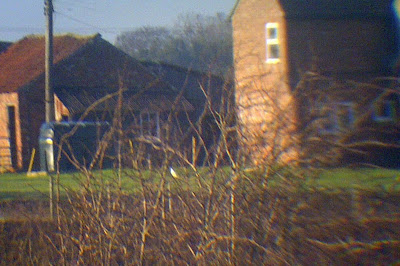Many apologies for something we do not like doing – but there has been a cattle egret present next door to Tophill Low Nature Reserve since at least the 29th of December – and is undoubtedly Bob Askwith’s
bird from Kelk on the 18th and 19th of that month – and the Sunk Island bird from November the 7th.
This is as we can work out about the 10th for Yorkshire and the first readily visible since the Fairburn bird of October 2006.
The reason we have not put this out sooner was at the request of the land-owner because it had only been showing on private farmland and was not visible from Tophill. Whilst visible from the road it is single track and would not support the traffic parked up. Before anyone levels ‘suppressors’ against us – we were not at liberty to disclose this information and create an access issue for private farmers. Prior to this morning the number of Tophill regulars who had seen the bird could be counted on less than one hand (and not me either). At the invite of a local landowner one member of
Hull Valley Wildlife Group obtained these pictures yesterday:



Based on the land-owners initial photo:

We had assumed the bird would quickly end up in a publicly viewable area and we could put it out – however it obviously likes it and is apparently feeding most days in a field of sheep near Larum Farm, Hempholme. Since this morning it has come to our attention the bird has been rumbled so we now need to get the news out to avoid potential conflicts over access.
We have tried in the last two weeks to negotiate parking with local farmers unsuccessfully – so at present vehicles are requested to park at Tophill Low NR car park (normal admission applies) or find a sensible and legal location – probably nearer Brandesburton – we have yet to find one to recommend but will keep you posted. Vehicles are requested NOT to park on the verges of the single track road to and from Hempholme village – or in the village/hamlet itself (which is little more than a farm yard). We have been in touch with the land owners, parish councillor and local police to advise that we are publicising the bird with this proviso.
There is nothing to restrict access to the usual rights of way – but again DO NOT enter private farmland or leave the paths – we have been specifically asked to make this be known by the Farmers. The link
here shows the usual centre of activity to the south of the village.
Note the public footpath across the fields – we have spoken with the farmer and suggested people will be using this – currently it is ploughed – but please stick to it. They have also asked to point out there is no access to the east bank of the river Hull above Hempholme Lock.
At lunch time today the bird could be viewed from within Tophill in the fields to the east of the river.
Ultimately make a day of it – there are a few good year ticks from the car park to Hempholme – willow tit, goldcrest and kingfisher in D woods, with potentially three species of owl present around Hempholme – like the short-eared’s courtesy of Rory:

And John Hirschfield:

Unfortunately no green-winged teal or greeland white front sightings of late. But the smew and garganey have still been seen on Watton today with egyptian goose and pintail and a 1st winter med gull on O res. Beware too of the pair of little egrets also regularly around Hempholme.
Once again we are very sorry we couldn’t let people know for their ’11 lists – but as you’ll appreciate our hands are tied when on private property.
Enjoy the bird and view it responsibly – if we as birders are seen to be a nuisance we will never hear about future birds that frequent the area also.



















































